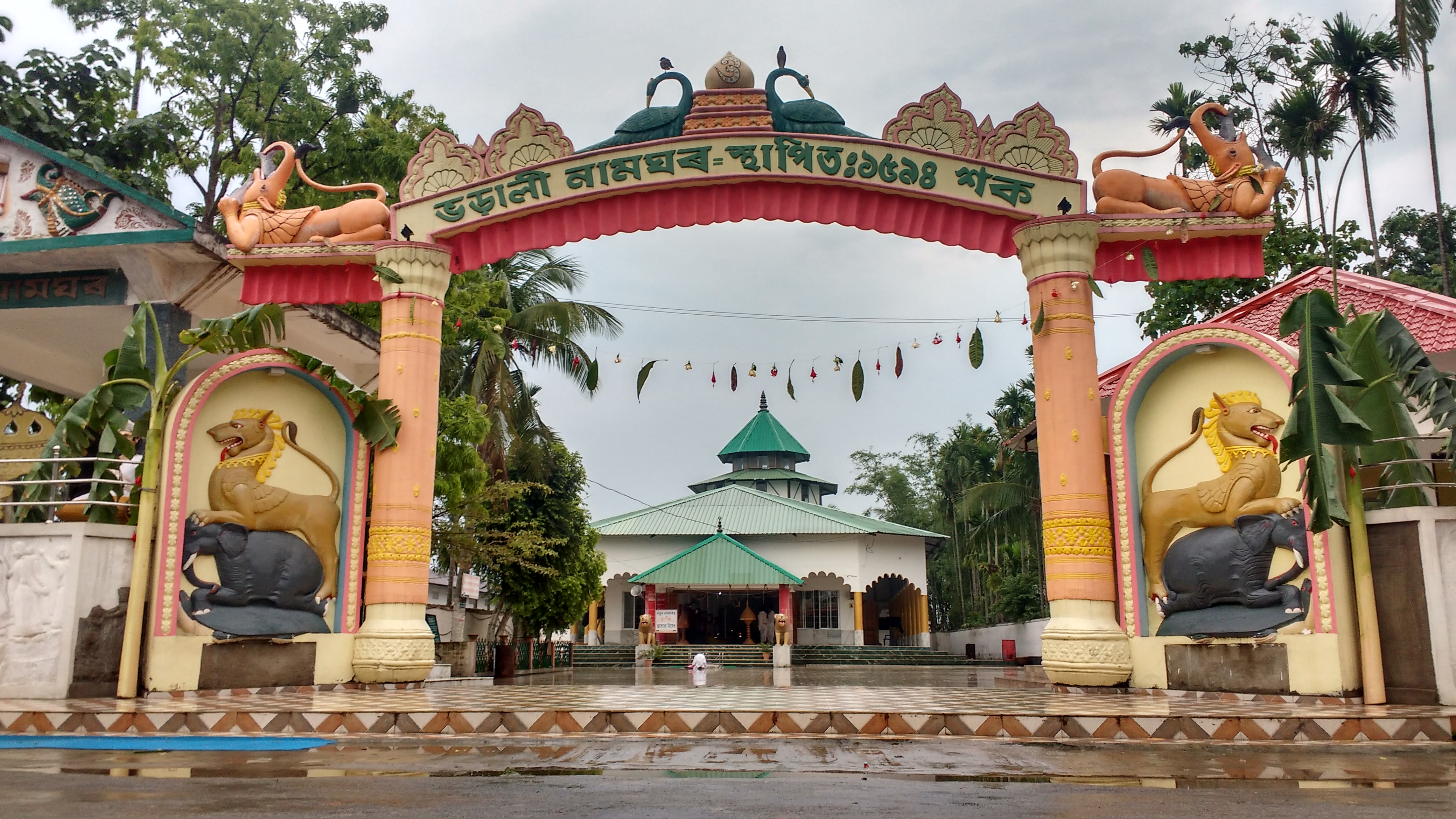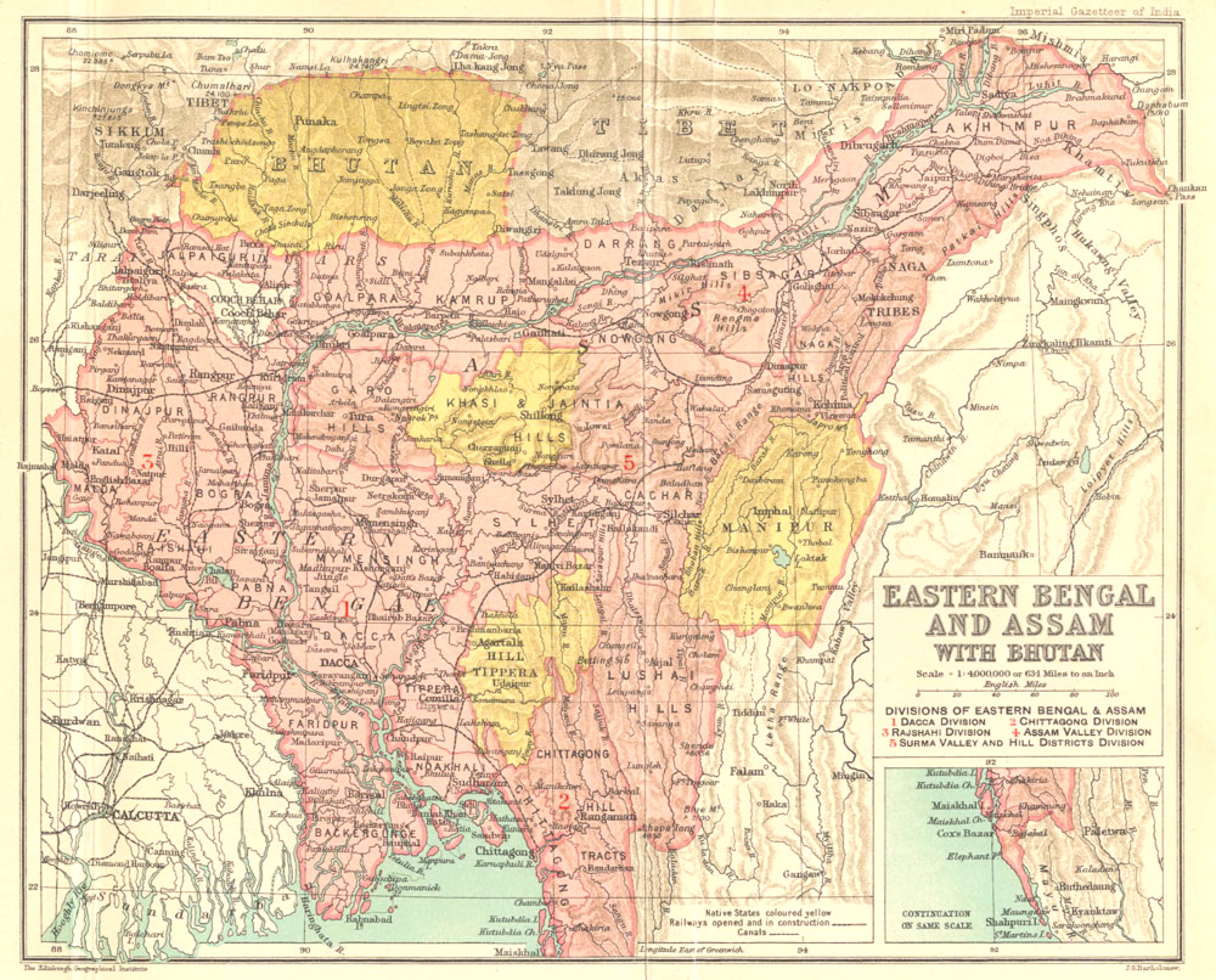|
Bharali Namghar
Bharali Namghar ( as, ভঁৰালী নামঘৰ) is a temple situated in Bharali village, India. Bharali is approximately 2 km away from Hatbor, a place of historical importance under the Kaliabor subdivision in the Nagaon district, Assam in India. People from the Nagaon district are mostly agriculture oriented and are guided by rich Sattria ( Eksarana religion) culture. History For about 150 to 200 years Bharali Namghar was situated in the then 'Bamgaon', currently known as 'Daulpukhuri'. Bapuram Deo of Balisatra took the initiative in establishing the Namghar. The Namghar was burnt down by the Burmese Army (during the Burmese invasion of Assam between 1817 and 1826). Having no other option, the villagers left the place and re-established themselves in Bharali Gaon. Accordingly, the Namghar (popularly known as Bharali Namghar) came into being. One of the interesting aspects of the Bharali Namghar is the 'Laikhuta' (main pillar of the building) made by Tulsi tree ... [...More Info...] [...Related Items...] OR: [Wikipedia] [Google] [Baidu] |
Hatbor
Hatbor is a small town in Nagaon district, Assam under Kaliabor Kaliabor, a sub-division town in Nagaon district of Assam situated at a distance of 48 km east of Nagaon town. It was the headquarters of Borphukans during the Ahom era. Kaliabor lies in the middle of assam and surrounded in the north by t ... sub division. Villages in Nagaon district {{assam-geo-stub ... [...More Info...] [...Related Items...] OR: [Wikipedia] [Google] [Baidu] |
Kaliabor
Kaliabor, a sub-division town in Nagaon district of Assam situated at a distance of 48 km east of Nagaon town. It was the headquarters of Borphukans during the Ahom era. Kaliabor lies in the middle of assam and surrounded in the north by the Brahmaputra, in the south by the hills of Karbi Anglong district, in the east by Kaziranga National Park under Golaghat district and in the west by Samaguri under Nagaon Sadar Sub-Division. Kaliabor – ''the rice bowl of Assam'' – Kaliabor occupies an important place in the annals of Assam history. The name "Kaliabor" owes its origin to the word "Tun-Rung-Dam", which means 'A Place of Black Big Trees' in the Tai language (Tun = Black, Run = Big, Dam = Tree). Kaliabor is famous for its several tourist spots both religious and natural. Distinct religious site includes Bhorali Namghar, Kamakhya Temlple, Hatimura Durga Temple. Education School * Kaliabor College * Pachim Kaliabor High School * Khaloiati LP School * Kuwaritol High Sc ... [...More Info...] [...Related Items...] OR: [Wikipedia] [Google] [Baidu] |
Nagaon District
Nagaon is an administrative district in the Indian state of Assam. At the time of the 2011 census it was the most populous district in Assam, before Hojai district was split from it in 2016. History Batadrowa gave birth to the Vaishnavite reformer Sankardev, who brought about a renaissance in Assamese society. Located in Assam's heartland, Nagaon lies at the center of northeast India. The district dates to 1833. Its British administrators jocularly described Nagaon as a district of 3 C’s; namely: Chickens, Children and Cases. The region was called ''Khagarijan'' in older records. On 15 August 2016, the three tehsils of Nagaon district, namely Hojai, Doboka and Lanka were carved out to form the Hojai district. Geography The district headquarters are located at Nagaon. A part of the Kaziranga National Park is located within the Nagaon district. The district is bounded by the Brahmaputra river in the north (across the river is Sonitpur district, West Karbi Anglong di ... [...More Info...] [...Related Items...] OR: [Wikipedia] [Google] [Baidu] |
Assam
Assam (; ) is a state in northeastern India, south of the eastern Himalayas along the Brahmaputra and Barak River valleys. Assam covers an area of . The state is bordered by Bhutan and Arunachal Pradesh to the north; Nagaland and Manipur to the east; Meghalaya, Tripura, Mizoram and Bangladesh to the south; and West Bengal to the west via the Siliguri Corridor, a wide strip of land that connects the state to the rest of India. Assamese language, Assamese and Boro language (India), Boro are the official languages of Assam, while Bengali language, Bengali is an additional official language in the Barak Valley. Assam is known for Assam tea and Assam silk. The state was the first site for Oil well, oil drilling in Asia. Assam is home to the one-horned Indian rhinoceros, along with the wild water buffalo, pygmy hog, tiger and various species of Asiatic birds, and provides one of the last wild habitats for the Asian elephant. The Economy of Assam, Assamese economy is aided by w ... [...More Info...] [...Related Items...] OR: [Wikipedia] [Google] [Baidu] |
Ekasarana Dharma
Ekasarana Dharma (literally: ''Shelter-in-One religion'') is a neo-Vaishnavite monolithic religion propagated by Srimanta Sankardeva in the 15th-16th century in the Indian state of Assam. It reduced focus on vedic ritualism and focuses on devotion (''bhakti'') to Krishna in the form of congregational listening (''sravan'') and singing his name and deeds (''kirtan''). The simple and accessible religion attracted already Hindu as well as non-Hindu populations into its egalitarian fold. The neophytes continue to be inducted into the faith via an initiation ceremony called ''xoron-lowa'' (literally: take-shelter), usually conducted by ''Sattradhikars'', heads of monastic institutions called Sattras, who generally draw apostolic lineage from Sankardev. Some Sattradhikars, especially those from the Brahma-sanghati, reject apostolic lineage from Sankardev due to an early schism with the order. Some modern reformation institutions conduct ''xoron-lowa'' outside the ''sattra'' ins ... [...More Info...] [...Related Items...] OR: [Wikipedia] [Google] [Baidu] |
Burmese Invasions Of Assam
Burmese may refer to: * Something of, from, or related to Myanmar, a country in Southeast Asia * Burmese people * Burmese language * Burmese alphabet * Burmese cuisine * Burmese culture Animals * Burmese cat * Burmese chicken * Burmese (horse), a horse given to Queen Elizabeth II * Burmese pony, a breed of horse * Burmese python See also * * :Burmese people * Bamar people The Bamar (, ; also known as the Burmans) are a Sino-Tibetan ethnic group native to Myanmar (formerly Burma) in Southeast Asia. With approximately 35 million people, the Bamar make up the largest ethnic group in Myanmar, constituting 68% of ..., the majority ethnic group in Myanmar * Burmese English, the dialect of English spoken in Myanmar/Burma * Bernese (other) {{disambig Language and nationality disambiguation pages ... [...More Info...] [...Related Items...] OR: [Wikipedia] [Google] [Baidu] |
Bhaona
Bhaona ( as, ভাওনা) is a traditional form of entertainment, with religious messages, prevalent is Assam, India. It is a creation of Mahapurusha Srimanta Sankardeva, written in the early sixteenth century. He created the form to convey religious messages to villagers through entertainment. Later Srimanta Madhavdeva also wrote some plays. The plays of bhaona are popularly known as Ankiya Nats and their staging is known as bhaona. Bhaona is generally staged at xatras and namghars in Assam. There are some special characteristics of Bhaona like the plays, dialogues, costumes, ornaments, entry and foot-steps of the characters. These characteristics helps to differentiate Bhaona from other plays. The bhaonas are written in the Assamese and Brajavali languages. In order to witness the Bhaona culture and traditions, one ought to visit Majuli, the largest river island in the world. Majuli receives a huge footfall of foreign tourists from all over the world every year. The na ... [...More Info...] [...Related Items...] OR: [Wikipedia] [Google] [Baidu] |
Sankardev
Srimanta Sankardev( শ্ৰীমন্ত শংকৰদেৱ )(; ; 1449–1568) was a 15th–16th century Assamese polymath; a saint-scholar, poet, playwright, dancer, actor, musician, artist social-religious reformer and a figure of importance in the cultural and religious history of Assam, India. He is widely credited with building on past cultural relics and devising new forms of music (Borgeet), theatrical performance ( Ankia Naat, Bhaona), dance ( Sattriya), literary language (Brajavali). Besides, he has left an extensive literary oeuvre of trans-created scriptures ( Bhagavat of Sankardev), poetry and theological works written in Sanskrit, Assamese and Brajavali. The Bhagavatic religious movement he started, Ekasarana Dharma and also called Neo-Vaishnavite movement, influenced two medieval kingdoms – Koch and the Ahom kingdom – and the assembly of devotees he initiated evolved over time into monastic centers called Sattras, which continue to be important soc ... [...More Info...] [...Related Items...] OR: [Wikipedia] [Google] [Baidu] |
Madhavdev
Madhavdev (1489–1596) (Pron: ˈʃrɪ ˈʃrɪ ˈmɑ:dəbˌdeɪv) is an important preceptor of the Ekasarana Dharma known for his loyalty to his guru, Srimanta Sankardev as well as his artistic brilliance. Initially a sakta worshipper, he was converted to Ekasarana Dharma by Sankardev and became his most prominent disciple. He became the religious as well as artistic successor of Sankardeva after the latter's death in 1568. He is known particularly for his book of hymns, the Naam Ghosa, as well as a large selection of songs called ''Borgeets''. Biography Early life in adversity Madhavdev was born in May 1489 at Baligrama in Lakhimpur District of Assam to Govindagiri Bhuyan and Manorama. Govindagiri was a descendant of Hari Bhuyan one of the Bhuyan's who accompanied Candivara (Sankardev's forefather) in the 14th century as part of an exchange between Dharmanarayana of Gauda and Durlabhnarayan of Kamarupa-Kamata. Govindagiri became a Majinder at Banduka, (in Rangpur Distr ... [...More Info...] [...Related Items...] OR: [Wikipedia] [Google] [Baidu] |



